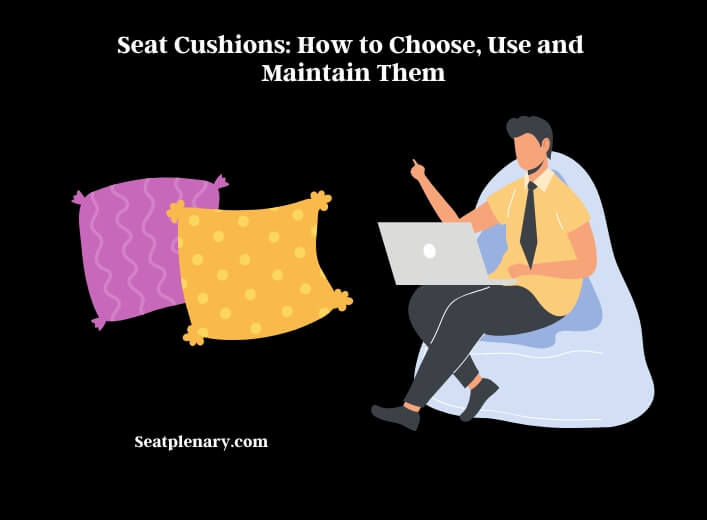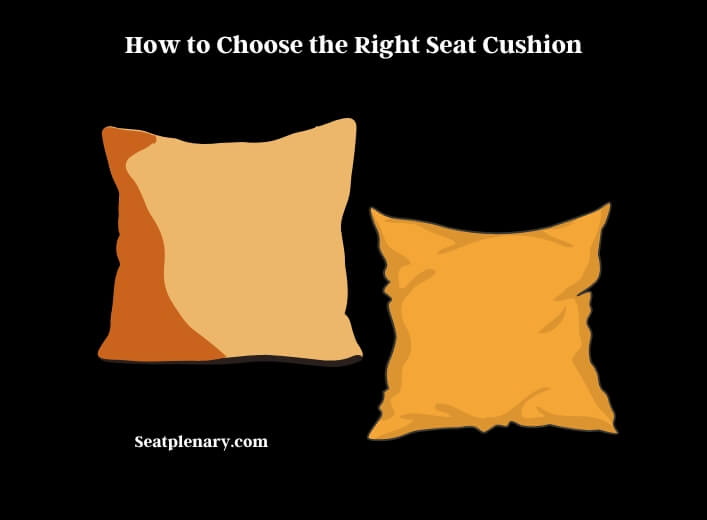Do you spend long hours sitting at a desk, driving, or in a wheelchair? If so, you may have experienced discomfort or pain from sitting for extended periods. Fortunately, seat cushions can offer a simple solution to make sitting more comfortable and supportive.

Seat cushions come in various shapes, sizes, and materials, and they can be used for a variety of purposes. Some are designed to alleviate pressure points, others to improve posture, and some to provide added comfort. Regardless of their intended purpose, seat cushions have become an essential item for many people who spend extended periods sitting.
Types of Seat Cushions
There are several types of seat cushions available, each designed to provide a unique benefit. Here are some of the most common types of seat cushions:
Memory Foam Cushions
Memory foam cushions are made from a high-density foam that conforms to the shape of your body, providing customized support. These cushions are known for their ability to distribute weight evenly and relieve pressure points, making them ideal for people with back pain or those who sit for long periods.
Gel Seat Cushions
Gel seat cushions are made from a layer of gel encased in a foam or fabric cover. These cushions are designed to reduce pressure on your tailbone and improve circulation, making them an excellent choice for people with coccyx pain or those who sit for long periods.
Wedge Cushions
Wedge cushions are triangular-shaped cushions that are designed to tilt your pelvis forward, improving your posture and reducing pressure on your lower back. These cushions can be used on a chair or in a car seat, making them ideal for people who spend a lot of time driving.
Coccyx Cushions
Coccyx cushions are designed to relieve pressure on your tailbone and provide support to your lower back. These cushions are shaped like a horseshoe and have a cutout at the back to reduce pressure on the coccyx.
Donut Cushions
Donut cushions are also known as ring cushions because of their circular shape with a hole in the center. These cushions are designed to provide relief to people with hemorrhoids, coccyx pain, or those who have recently undergone surgery. The hole in the center of the cushion relieves pressure on the affected area while sitting.
How to Use Seat Cushions
Using a seat cushion is relatively simple, but there are a few things you should keep in mind to ensure that you get the most benefit from it. Here are some tips for using a seat cushion:
Position the cushion correctly: Make sure that the cushion is positioned correctly on your chair or seat. Some cushions have a non-slip bottom that will help keep them in place. If your cushion does not have a non-slip bottom, you can use a piece of rubber shelf liner or double-sided tape to keep it from sliding.
Sit back in your chair: When using a seat cushion, it’s important to sit back in your chair and use the cushion to support your lower back or tailbone. Avoid sitting on the edge of your chair or slouching forward, as this can put additional pressure on your spine and cause discomfort.
Adjust the cushion as needed: If you find that the cushion is not providing enough support or is causing discomfort, try adjusting it. Some cushions have removable inserts that allow you to customize the level of support.
Take breaks: Even with a seat cushion, it’s important to take breaks from sitting every 30 minutes to an hour. Stand up, stretch, and move around to promote circulation and prevent stiffness.
How to Choose the Right Seat Cushion
Choosing the right seat cushion can make a significant difference in your comfort level while sitting. Here are some factors to consider when selecting a seat cushion:

Purpose
Consider the purpose of the cushion. Are you looking for relief from back pain, tailbone pain, or discomfort caused by sitting for long periods? Knowing the purpose will help you narrow down your options.
Material
Seat cushions can be made from various materials such as foam, gel, or air. Each material has its unique properties, and choosing the right one depends on your needs. For example, memory foam cushions provide customized support and distribute weight evenly, while gel cushions can reduce pressure on the tailbone.
Size
Make sure that the cushion is the right size for your chair or seat. An ill-fitting cushion can shift or slide, reducing its effectiveness.
Shape
The shape of the cushion is also essential. Some cushions are designed to tilt your pelvis forward, improving your posture, while others are shaped like a horseshoe to relieve pressure on the coccyx.
Maintenance
Consider how easy the cushion is to clean and maintain. Some cushions come with removable covers that are machine washable, while others require spot cleaning.
Budget
Seat cushions can range from inexpensive to quite costly, so consider your budget when choosing a cushion. Keep in mind that a more expensive cushion may offer better support and last longer.
Maintenance and Care for Seat Cushions
Proper maintenance and care of your seat cushion can help extend its lifespan and ensure that it continues to provide the support and comfort you need. Here are some tips for maintaining and caring for your seat cushion:
Check for Wear and Tear
Inspect your cushion regularly for any signs of wear and tear, such as rips or tears in the fabric. If you notice any damage, repair or replace the cushion as needed.
Clean the Cushion Regularly
Depending on the material of your cushion, it may need to be cleaned regularly. Some cushions have removable covers that can be machine washed, while others may need to be spot cleaned with a mild detergent and water.
Allow the Cushion to Air Out
If your cushion is made of foam or other materials that can absorb moisture, allow it to air out periodically. This can help prevent mold or mildew from developing.
Store the Cushion Properly
When not in use, store your cushion in a cool, dry place away from direct sunlight. Avoid storing the cushion in a compressed or folded position, as this can damage the cushion’s shape and effectiveness.
Replace the Cushion as Needed
Over time, seat cushions may lose their shape and support, reducing their effectiveness. If you notice that your cushion is no longer providing the support and comfort you need, it may be time to replace it.
Benefits of Using Seat Cushions
Using a seat cushion can offer several benefits for your comfort and health, including:
Reduced Pressure on the Spine and Tailbone
Sitting for long periods can put pressure on your spine and tailbone, causing discomfort or pain. A seat cushion can help distribute your weight evenly and reduce pressure on these areas, reducing the risk of discomfort or pain.
Improved Posture
Some seat cushions are designed to promote proper posture by tilting your pelvis forward or providing support to your lower back. Improved posture can help reduce strain on your muscles and joints and prevent back pain.
Increased Comfort
A seat cushion can provide additional padding and support, making your chair or seat more comfortable to sit in for longer periods.
Enhanced Circulation
Sitting for long periods can lead to reduced circulation in your legs and feet, causing discomfort or even numbness. Some seat cushions are designed to improve circulation by reducing pressure on the back of your legs and promoting blood flow.
Tailored Support
Some seat cushions have adjustable inserts or layers that can be customized to your specific needs. This allows you to tailor the level of support to your comfort and health requirements.
Improved Productivity
By reducing discomfort and pain, a seat cushion can help you stay focused and productive while sitting for long periods.
Conclusion
Seat cushions can provide significant benefits for your comfort and health while sitting for long periods. They can help reduce pressure on your spine and tailbone, improve posture, increase comfort, enhance circulation, provide tailored support, and improve productivity.
When choosing a seat cushion, consider the material, size, shape, and type of cushion that best suits your needs. Ensure that you use the cushion correctly and maintain it properly to prolong its lifespan and effectiveness.
Investing in a good quality seat cushion can make a significant difference in your sitting experience, whether you are sitting at your desk, in your car, or on a plane. By taking the time to research and choose the right seat cushion for your needs, you can enjoy improved comfort, health, and productivity while sitting for long periods.
